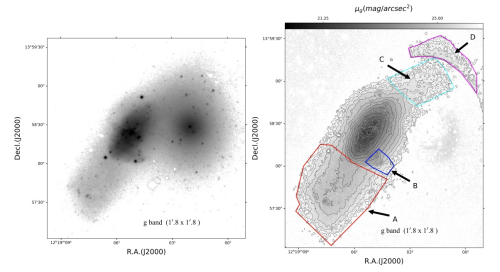Interactions between galaxies, including mergers and tidal interactions, have been extensively studied. It has been established that mergers between massive galaxies can alter galaxy morphologies, enhance star formation, and even trigger starbursts. Due to the weak gravitational potential wells of dwarf galaxies, their star formation distribution and density are more easily affected by mergers and stellar negative feedback. However, observational limitations have resulted in less research on merging dwarf galaxies.
Utilizing data from the Next Generation Virgo Cluster Survey project, ZHANG Lanyue from Yunnan Observatories, Chinese Academy of Sciences(CAS), and her collaborators analyzed the tidal tails of the dwarf galaxy VCC322 produced by merger. They determined the metallicity and stellar age of the tidal tails based on color and single stellar population model fitting. Isophotal fitting revealed isophotal twisting inside a neighboring dwarf elliptical galaxy VCC319, suggesting that this galaxy was also affected by the merger.
Based on spectral data fitting of stellar population information and star formation rates, it was found that VCC322 has experienced recent star formation, although at a low star formation rate. Comparing VCC322 with other star-forming dwarf galaxies in the Virgo cluster and with merging dwarf galaxy systems in terms of neutral hydrogen mass and star formation rates, the researchers identified a suppression of its star formation.
Furthermore, by comparing the emission line flux ratios obtained from spectral data with shock models, the researchers suggest that shocks generated by mergers/interactions are present within VCC322, heating the gas and thus inhibiting star formation.
This study was published in The Astrophysical Journal. This work is supported by the National Natural Science Foundation of China, China Space Station Telescope grant.

Figure 1, 1′.8×1′.8 g-band image of VCC322/319 from Canada–France–Hawaii Telescope/MegaCam. Colored polygons represent different tidal features. Image by ZHANG.

Figure 2, the results of comparing the emission line flux ratios obtained from spectral data with shock models, with the gradient blue for different magnetic fields and the gradient orange for different shock velocities. Image by ZHANG.
Contact:
ZHANG Lanyue
Yunnan Observatories, CAS
E-mail:zhanglanyue@ynao.ac.cn